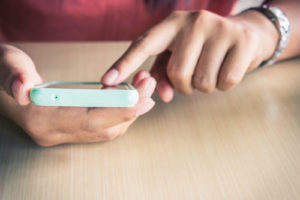Take a seat in any college lecture this week, and this scene of mass distraction will likely play out: Somewhere in the room, a student will open a laptop and begin clicking the keys in rhythm while the professor lectures. Another student a few seats away will be following along with the textbook downloaded on an iPad.

And at some point the cellphone sitting on a tabletop will vibrate, sending a buzz through the air before the user silently hides the phone under the table and begins to text.
Classroom electronics use is as expected as freshmen seeking a house party on the semester’s first weekend. But it’s cell phone use, particularly use of smartphones, that educators are still grappling with, even as technology becomes one of the top components of students’ lives.
“It’s a case of the rules catching up with the technology,” said Ben Clansy, a College of Saint Rose political science professor.
For the most part, high schools have blanket cellphone use policies: use is OK in the halls or cafeteria but banned in the classroom.
College has a different set of rules — or lack thereof — that now deals less with passing notes in class and more with texting, tweeting and scrolling during lectures.
Clansy has a cellphone policy that allows use in emergencies, but if the phone dings, rings or makes any noise other than the buzz of vibration mode there will most likely be some words exchanged after class.
He isn’t alone. Saint Rose counseling associate professor Claudia Lingertat-Putnam has a similar policy for her graduate students, some of whom leave their phones on to check on children or spouses.
But the policies haven’t stopped, nor will they stop, the student who will check out mid-lecture to check in on social media.
“It’s like note-passing, that’s what I equate it to,” Lingertat-Putnam said. “Whether it’s passing notes or texting, there are always going to be students who are disengaged or distracted.”
That realization has created two standards for educators. While most allow laptops because of their educational value — despite their risk of distraction — cellphones have yet to become recognized as a learning tool. With the laptop, anyway, there is an expectation that those students know how to use the technology properly.
“It’s the person, not the tool,” Lingertat-Putnam said.
Her graduate classes are based around small group discussions and lectures. That requires students to place extra emphasis on the discussion not their cellphones. Still, she sometimes will have students research information on their phones to add to the discussion, one reason she said she hopes technology becomes more commonplace in the classroom.
As societal norms shift to accept technological distractions (who hasn’t quickly read a text mid-conversation?), professors have begun to shift their policies accordingly, both to be accepting and restrictive.
Saint Rose elementary education field supervision coordinator Joe Schaefer said that when cellphone policies were first developed, they took into account disruptive rings and students taking phone calls mid-class, not texting.
While Lingertat-Putnam, Clansy and Schaefer all shun texting in class, students’ views of what is disruptive differ.
Lingertat-Putnam said she had a graduate student who once sat in the front row and during one class was attentive the first hour but constantly texting the second hour.
It turned out the student had a crisis at work to deal with mid-class. When Lingertat-Putnam questioned why the student didn’t just leave the room, the response was, “Oh, I can do that?”
“She thought it would be more disruptive to leave the room,” Lingertat-Putnam said.
Some students also see texting as a drawback only for themselves because they are the ones missing part of the lecture. Lingertat-Putnam still sees it as rude.
“Would you tolerate it from your professor?” she asked. “Then why is there a double standard?”
Regardless of manners, the three professors will still deal with students distracted by a cellphone at some point this semester. The question isn’t is it OK, rather what are the boundaries, Clansy said.
(c)2013 the Times Union (Albany, N.Y.) Visit the Times Union (Albany, N.Y.) at www.timesunion.com Distributed by MCT Information Services
- Extron AV Switching, Streaming, and Control Systems Aid Higher Learning at Idaho’s First Medical School - June 1, 2021
- Extron XTP, Streaming, and Control Systems Empower Point Park University’s Varsity Esports Program - June 1, 2021
- Extron NAV Series Delivers AVoIP Throughout Allied Health Veterans Hall at UNC Wilmington - June 1, 2021

